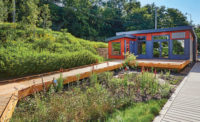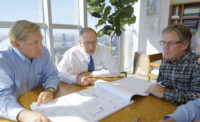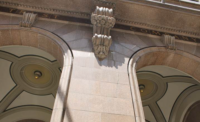
Related Article:
Seattle's Living Laboratory Tests Novel Low-Carbon Building Materials
Back to:
25 Top Newsmakers
Veteran structural engineer Don Davies often confesses that by his own calculations, his annual personal carbon footprint is a whopping 10 times the world average and 3½ times the U.S. average.
“I drive an electric car, I have solar panels on my house and I live in a green-grid electricity location, but I also fly a lot,” explains Davies, cofounder, with his wife Joan Crooks, of the fledgling sustainability consultant Davies-Crooks Associates.
Flying a lot is an understatement. During his first decade at Seattle-based structural engineer Magnusson Klemencic Associates (MKA), which he left last February after 33 years, Davies says he had a passport stamp every single month from someplace in Southeast Asia.
But instead of grounding himself, Davies thinks he can have a bigger positive impact on climate change by working to reduce the high embodied carbon of concrete. Risking their own millions, he and Crooks donned developers’ hats. They are upgrading a 5,126-sq-ft building, called Hubbard’s Corner, as a living test laboratory to debut novel green materials. “I saw an opportunity to put into practice many things we talked about but never as a structural engineer had the opportunity to control,” says Davies, who is moving his office into the building, in March.
Davies’ shift to the front lines of fighting climate change has two goals—removing, for others, the fear factor associated with specifying the latest eco-friendly products that do not have track records for constructability, durability and long-term performance, and creating a development model for embodied-carbon reduction.
An avid runner who grew up in the mountains of central Idaho and who, with Crooks, owns his family’s farm, Davies has nature in his bones. “I was drawn to working on tall buildings to make the urban environment livable and preserve the natural landscape,” he says.
Until Hubbard’s Corner, Davies’ carbon reduction work was behind the scenes. He is a cofounder of the Carbon Leadership Forum. He was part of the team that developed EC3, as it is known, which was the first free digital tool to measure the embodied carbon in a building project. At MKA, he helped write the Hines Embodied Carbon Reduction Guide. And he currently serves as board chair for the nonprofit Building Transparency, which administers EC3 and more.
Davies owes his environmental activism in part to Crooks, whom he met through mutual friends while climbing Mt. Adams, soon after moving to Seattle in 1987. In 2020, Crooks left the Washington Environmental Council, an advocacy group she led for 25 years. “I don’t kid myself that we are going to solve these [climate change] problems with Hubbard’s Corner, but it’s a start,” she says.
More than a start, Hubbard’s Corner is a launch pad for a global movement, beginning with an initiative of the ClimateWorks Foundation. Davies is leading a team that is creating eight projects as case studies to demystify lower-carbon concrete mixes for different building types, applications and locations. The results will be shared, free of charge.
“The ambition is to change the global cement and concrete [sectors] by first seeding best practices across the
U.S., and then have the participants spread the practices far and wide,” says Scott Shell, associate director for industry at ClimateWorks. “Don is trusted and an expert, known all over the world,” Shell adds, saying industry leaders listen to him.
Denis Hayes, a past ENR Newsmaker for Seattle’s super-sustainable Bullitt Center, which was Project of the Year for ENR’s Best of the Best Projects in 2013, says, “Don feels the world is in desperately bad shape and wants to do everything he can to fix it. He’s already had an impact.”
All ENR 2023 Top 25 Newsmakers will be honored at the Award of Excellence Gala on April 11 in New York City.






Post a comment to this article
Report Abusive Comment